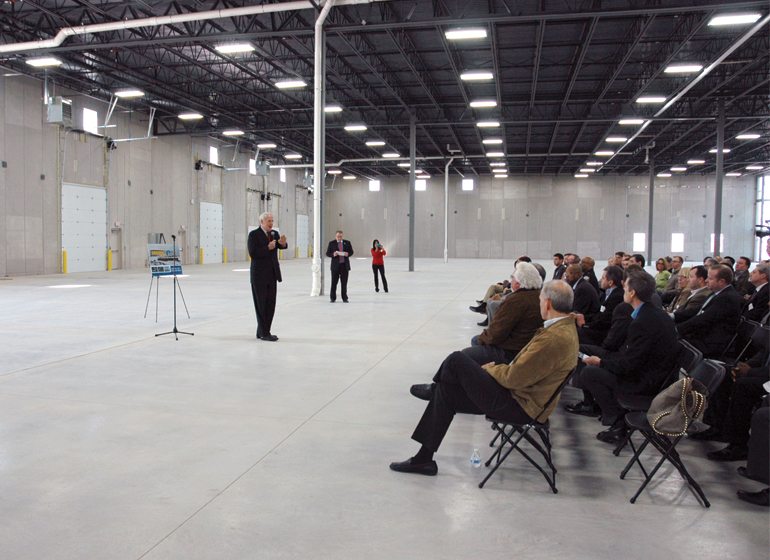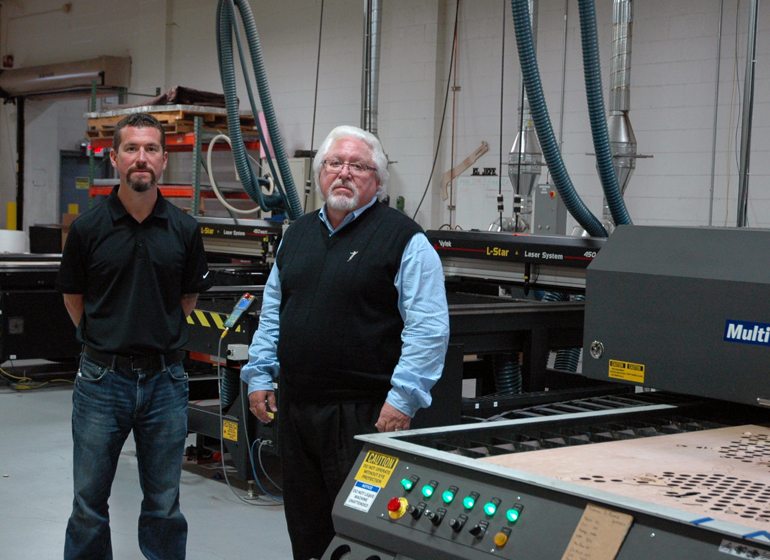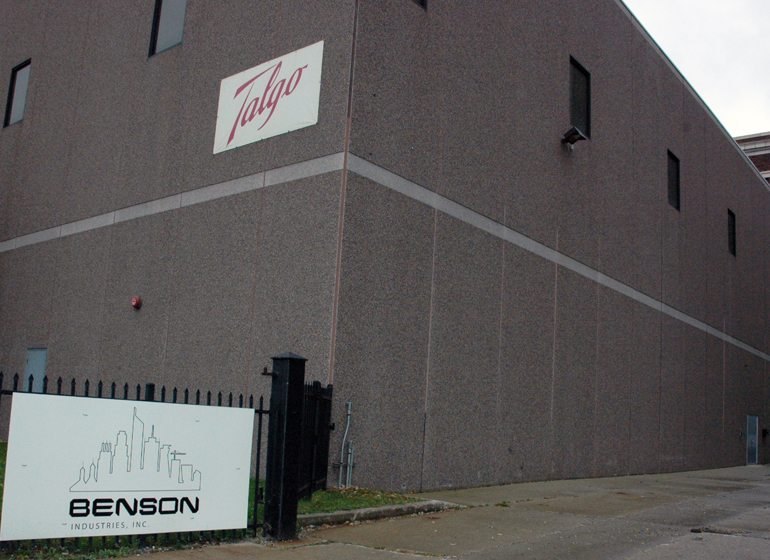Milwaukee Mayor Tom Barrett told members of the commercial real estate community, during an April open house, that the Century City project is an important test for the community.
“It may not be an easy test, but we all recognize this neighborhood needs more family-supporting jobs,” Barrett said, his voice echoing through Century City I, a new 53,000-square-foot industrial building.

The Century City Business Park is the city’s top initiative to attract much-needed jobs to the inner city. Located on the north side in the heart of the city’s 30th Street Industrial Corridor, the 84-acre Century City Business Park is a redevelopment of much of the former A.O. Smith Corp. (and later Tower Automotive) manufacturing complex site at West Capitol Drive and North 31st Street. Most of the original buildings on the Century City site were torn down and Century City I, developed through a public-private partnership of the city and General Capital Group, is the first new building in the business park.
But the new building is vacant, as the city and General Capital are still seeking tenants.

Recently, Barrett said the August civil unrest in the city’s nearby Sherman Park neighborhood is a firsthand example of what happens when there aren’t enough jobs, combined with decades of concentrated poverty, and it shouldn’t be surprising the pressure cooker boiled over.
“There has been a sense of urgency for a long time,” he said in an interview.
Even with the increased attention on the area, Barrett and his administration aren’t looking for just any businesses to fill the new Century City building.
“Our focus has always been on getting it right, rather than getting it fast,” Barrett said.
Meanwhile, local and state leaders have ramped up their efforts to bring resources to the city’s north side neighborhoods, starting with $4.5 million aimed at job training and removing blighted houses.
Earl Buford, chief executive officer of Employ Milwaukee Inc., formerly the Milwaukee Area Workforce Investment Board, said the scale of the jobs problem facing the inner city is large.
“You’ve seen the results of not having our collective hands all around this; you see things popping up all the time because there’s some hopelessness,” he said.
In 2014, almost one-third of the city’s officially unemployed residents live in the zip codes surrounding the 30th Street Industrial Corridor (between Hampton Avenue, Highland Boulevard, 27th Street and 35th Street) and half the residents over 16 were either unemployed or not in the workforce. Poverty levels reached 50 percent in some areas and per capita incomes were as low as $11,163, just 57 percent of the citywide average.
“The inner city has fallen behind in Milwaukee,” said Abdur Chowdhury, Marquette University economics professor.
While manufacturing jobs in the state and country have rebounded and Milwaukee’s downtown booms with development, Milwaukee County has trailed other areas. Waukesha, Ozaukee and Washington counties have added private sector jobs at twice the rate since 2010. Milwaukee County manufacturing employment is essentially flat, while those counties are up more than 11 percent.

Attracting companies
Tom Ryan, president and owner of Jonco Industries Inc., 2800 W. Custer Ave., remembers what it was like when the 30th Street Industrial Corridor was at its peak, having worked at A.O. Smith Corp. in the 1960s.
He watched as the former Eaton Corp. facility on North 27th Street was built in 1965. Eaton left in 2012 and it took Ryan all of five minutes to decide to buy the seven-story building (now called Century City Tower) “because it should be done.”

In addition to the Century City Tower, Ryan and Jonco have six other facilities in the city, all of them located along bus routes. It might ease production to consolidate operations on one site, but Ryan says he finds it easier to repurpose buildings.
“I’ve never had a desire to move into the suburbs,” Ryan said, adding that many businesses leave thinking they’ll avoid crime. “I’m sorry, crime happens everywhere.”
If he could, Ryan says he would buy struggling suburban businesses and move them to Milwaukee. Instead, he’s started encouraging fellow business owners to relocate into the city. Not with a formal pitch in the boardroom but at social gatherings, on the golf course or in other relaxed environments.
“You get to talk to that person on a completely different level,” he said.
It is a message that doesn’t come without its challenges.
“You’ve got to convince the manufacturers and the smaller shops out there, I’d say the 10 to 50 employee companies that are in the suburbs, that there’s a vibrant community (in the central city),” he said. “Business owners have to make a conscious decision that this city is a valuable asset that they have to contribute to. Sometimes that means they should take a little risk.”
Kathryn Dunn, vice president for community investment at the Greater Milwaukee Foundation, said many organizations have already been working on long-term systemic issues and the Sherman Park unrest in August showed the need to have more partners at the table.
“It was an unfortunate happening, but I think it also shined a light on the need for this work to be closer to home for our corporate community and our other philanthropy partners,” she said.
Building the corridor
Jobs weren’t an issue in the central city when A.O. Smith and others employed thousands of workers. But as factories closed, the jobs left. Some went south, others overseas. In some cases, jobs went to the suburbs; in others, the jobs disappeared, eliminated by advances in technology.
The result is an area with some of the most troubling statistics when it comes to unemployment, income and poverty in southeastern Wisconsin.
Using a roadmap the city first followed in the Menomonee Valley, Century City represents an opportunity to change those figures and bring economic activity back to an area that once bustled with it. The city bought the land in 2009 and has spent $37 million clearing old buildings, remediating environmental issues and preparing the site for development.
And just like in the valley, the city is looking for the right business as the first occupant in the new building. The goal is to have 15 to 20 jobs per acre in the business park, said Rocky Marcoux, commissioner of the Milwaukee Department of City Development. The Menomonee Valley reached 26 jobs per acre, according to the Public Policy Forum.
“We get the money (spent by the city on the site) back by restoring the economy to that part of the city, and you do that by having the density of jobs,” Marcoux said.

The city moved some Department of Public Works jobs to the western portion of the former A.O. Smith site about 10 years ago. That made sense at the time, Marcoux said. But bringing additional public jobs to the site from elsewhere in the city wouldn’t provide any net gain for the economy, he said.
Marcoux also said the city isn’t interested in having storage or logistics operations in Century City I. Those are important operations, but he said there are other, more suitable, locations for them. It doesn’t do any good to fill the building with six people when it could support hundreds of employees, Marcoux said.
“We don’t want to fill it with just anything,” Marcoux said, noting he passed on a dozen proposals for the valley as big questions loomed about the project and commercial real estate brokers brought proposals that didn’t necessarily fit the vision for the site.
“Most people look at (the Menomonee Valley) now as a given,” he said. “But 10 years ago, it was as uncertain as the 30th Street corridor is today.”
Corey Zetts, executive director of Menomonee Valley Partners, said the valley took a lot of intensive planning and detailed thought about how to make it a reality. She said cooperation among public, private, regional, city and local entities also was key.
Zetts acknowledged the valley was fortunate to be the first in a series of redevelopment efforts, as the bar was set low. There’s also one major difference between the valley and the 30th Street Industrial Corridor: the latter is right in the heart of a residential area, making challenges more complex, she said.
Marcoux said Century City now rivals any suburban location for new development, with the unique advantage of being in the heart of a potential workforce.
“We’ve done something that the suburban communities are not able to do,” he said, arguing the population in the suburbs skews older, while the city is well-positioned with a younger workforce.
While there are no site-related incentives for Century City I, the Milwaukee Economic Development Corp. is in a position to provide low-interest loans to qualified businesses and the city would help coordinate workforce training and incentives for a business that chose the site, according to Department of City Development spokesman Jeff Fleming.

Since the events in Sherman Park, there have been two good pieces of news for Century City. Specialty vehicle maker Rev Group Inc. plans to conduct final assembly of next generation postal delivery vehicle prototypes at the site and train maker Talgo is bringing work back to Milwaukee.
“Those are voluntary; they don’t need to be there,” said Linda Gorens-Levey, a partner at General Capital Group. “There’s a renewed energy and focus and reason for optimism.”
But drawing companies to the corridor also is made more difficult by perceptions about the neighborhood’s safety.
“Growing a company in this world is tough enough, let alone to be in a ‘bad neighborhood,’” said Howard Snyder, executive director of the Northwest Side Community Development Corp. “And that’s the narrative that we always have to fight.”
Marcoux said businesses with security concerns may be making some assumptions about the situation that can be addressed with time spent in the area and he’s happy to give them tours.
The reality, though, is crime is higher in the three police districts covering the corridor than it is in the rest of the city. Nearly 70 percent of Milwaukee’s homicides since 2010 have occurred in those districts. A majority of the assaults, burglaries, robberies and vehicle thefts have occurred there as well, while the districts account for 42 percent of the city’s population.
Gary Wenzel, president of Capitol Stampings, located at 2700 W. North Ave., said concerns about safety make it difficult to recruit talent in skilled trades.
“There’s a lot of talk out there, but to me, I don’t see enough action,” he said.
Safety concerns aside, whether the workforce in the immediate area around the corridor has the skills employers need remains a bit of an open question. Barrett and Marcoux have positioned the Century City site as being located close to a ready labor pool. Marcoux pointed to Talgo’s decision as proof companies can find quality employees.
But millions of dollars are spent each year in the city to train workers and more than 100 organizations are engaged in some training. Employ Milwaukee alone has an approximately $20 million budget and 85 percent of its money goes out the door to support various training programs.
Marcoux said there are two groups making up the workforce around the corridor. One is an older group, made up of residents who worked in manufacturing before the jobs left and can easily adapt to new jobs. The other is a younger cohort who may not have the skills or educational levels employers are seeking.
“Those are real issues; I’m not going to say they’re not,” he said.

Balancing the workforce
Buford’s organization is in the midst of an effort that in many ways runs parallel to the work at Century City. While Century City is about attracting new business, Employ Milwaukee is trying to prepare the city’s workforce for available jobs, as well as the jobs of the future.
Former Alderman Willie Wade, now Employ Milwaukee’s vice president of community relations, said the organization’s mission is about creating a paradigm shift around workforce, stressing necessary changes to job seekers.
“You may have to stop drinking or getting high or you may have to get your driver’s license cleaned up. You may have to do some other things that wasn’t your ordinary mode of operation, but if you want to get a job and take care of yourself and your family, these are the adjustments that you’re going to have to make,” Wade said.
The message to employers is equally stark.
“We also have to make sure we convey to the demand side that this is your workforce,” Wade said. “These are the issues that they have. No other workforce is coming in from somewhere else.”
Buford joined Employ Milwaukee in 2014 as CEO. He has since brought Wade and Pete Coffaro, the former business and community engagement manager at the Milwaukee Metropolitan Sewerage District, on board to help lead the organization.
Their goal is to serve as a middleman between employers and the workforce. While Wade works to bring organizations involved in job training together, Coffaro, vice president of business services, is strengthening relationships with the business community.
“You see a groundswell of employers and businesses recognizing that they’re having tremendous challenges when they look at their talent pipeline and they need to apply the very same business practices that they’ve used in supply chain management to human resource practices,” Coffaro said.
To engage with those employers, Employ Milwaukee launched industry advisory boards, drawing on companies and industry groups to develop career pathways, give candidates direction on which credentials to pursue and improve communication.
Employ Milwaukee also is shifting away from broad job fairs to more targeted industry recruitment.
To get a more detailed picture of the demand for certain skills, Employ Milwaukee has begun regularly completing job scans, surveying employers about their current and future openings in specific ways.

Wade is able to take the information and relay it to the job training community through a coordination council meant to bring organizations together instead of spending time working alone without a clear idea of employer demand.
“Getting those folks to stop looking at themselves as small businesses and think of ‘Well, if we’re going to make a collective impact in this community and leverage our resources, we’ve got to link arms.’ That to me is the hardest part of this job,” Buford said.
Wade said many organizations are worried about what collaborating will do to their funding.
“That’s what I see as the most intimidating thing,” he said. “They’re worried about, ‘If we do this, do we lose money?’ My message to them is, ‘No, we’re going to grow the pie.’”
The idea is that by working together, all the groups will be better able to meet their contract goals, giving them a better chance of finding more work and more funding.
Wade said the agency’s relationship with Milwaukee Public Schools also is important, giving Employ Milwaukee a chance to make sure the future workforce is on track.
“The more of those people that we can get into the workforce through that relationship and that opportunity, the less people that we have with the barriers on the other side,” Wade said.
When he served on the Common Council, Wade said he saw jobs as the No. 1 issue and “the key to turning Milwaukee around.” But he also said “mode of operation” over the past few decades meant the general community wasn’t prepared to take advantage of opportunities like the construction of the Northwestern Mutual Life Insurance Co. tower, the new Milwaukee Bucks arena or the Century City development.
Addressing workforce barriers like driver’s license issues, drug use and re-entry from the criminal justice system is part of preparing for those opportunities.
Those barriers are prevalent in the populations served by a number of the main workforce programs in the city. An October 2015 Public Policy Forum report found that among roughly 7,200 job seekers, 23 percent lacked a high school diploma or GED, 50 percent did not have a valid driver’s license and 42 percent had criminal backgrounds. A total of 39 percent had more than one of those barriers to employment.
With so many people lacking a driver’s license, public transportation becomes an important part of connecting the workforce to available jobs. But Joel Rast, director of urban studies at the University of Wisconsin-Milwaukee, said it is unlikely public transportation can solve the problem, because the percentage of employees going to the suburbs is small and it’s difficult to create efficient bus routes to those sprawled areas.
New bus routes into Menomonee Falls and New Berlin have been established in recent years with mixed results. The New Berlin route has capitalized on seasonal needs at costume supplier BuySeasons Inc. Two routes into Germantown and Menomonee Falls were cancelled due to lack of ridership.
One route to Menomonee Falls remains in operation.
The routes were funded by a settlement over the Zoo Interchange project, and face an uncertain future, as money is set to run out around 2018.
Even if the Milwaukee County Transit System can run a line to a suburban location, the time it takes to reach an employer may discourage potential riders.
“The reality is, nobody wants to ride a bus for two hours to get to a job,” Barrett said.
Snyder said a number of the Northwest Side CDC’s recent loans have been to companies near Good Hope Road “because we know people from here can get out there.” The area is home to two of the biggest business expansion projects announced in the city over the past year, as HellermannTyton Corp. and Direct Supply Inc. continue to grow.
Business involvement
Stephanie Harling, executive director of the Havenwoods Economic Development Corp., said businesses have to be able to attract and retain talent in a particular location and it is important for a company’s workforce to feel comfortable coming into a community. She said that wasn’t the case in the past and some businesses left because of it.
“We took that to heart and we started making sure our businesses knew what was going on in the community and they’re involved,” she said.
Getting businesses involved in volunteering, including rehabbing or beautifying homes, a neighborhood cleanup or running in the Havenwoods neighborhood’s 5K, has increased involvement and puts employees shoulder-to-shoulder with the residents they drive by every day, she said.
Closer to Century City, Vince Stammetti, vice president and general manager at DRS Power and Control Technologies Inc., a division of Arlington, Va.-based DRS Technologies, said it is the connection to the neighborhood that’s helped the company keep its presence there since 1952.
DRS, located at 4265 N. 30th St., recruits employees from the surrounding neighborhoods, handing out flyers and canvassing the area. It’s a process that recently generated 50 applicants and Stammetti said DRS is able to find the manufacturing talent it needs from the area.
He also said being involved in the community has reduced the number of issues DRS has faced.
“We’re very involved in the community because a lot of our folks live in the community,” he said, noting the company often contributes to food and school supply drives, provides Thanksgiving dinners to needy families, and holds an annual picnic.
DRS also has forged a relationship with officers from the Milwaukee Police Department, establishing a small substation at its facility that includes an office, restroom and microwave to make it easier to take breaks.
Wenzel also said he sees it as an advantage for Capitol Stampings to be located so close to a large labor pool. But he acknowledged that not being located in the suburbs adds to the difficulty of attracting highly skilled trades like tool and die makers, maintenance technicians and skilled punch press operators.
“That makes it a little more difficult recruiting people, but we do find them,” Wenzel said. “You’re going to pay more.”
To counter those challenges, the company has turned to internal training, developing apprentices and recruiting entry level employees with opportunities to advance within the company. Capitol Stampings also has invested in automation to improve efficiency and remain competitive.
A common complaint among manufacturers has been new employees from the central city lacking the soft skills required for regular employment. Wenzel is no different.
“I wish they were doing a better job in our middle schools and high schools preparing these kids, because when we get them, you just shake your head sometimes,” he said.
Despite the challenges, Wenzel said he has no plans to leave the area. The location is close to a large labor pool and he knows manufacturers around the state are facing the same challenges. He also said that in the past 11 years, Capitol Stampings’ sales have tripled.
“You don’t do that without good people,” he said.
Barrett, Marcoux and Wade all believe being close to the workforce is going to draw companies to the 30th Street Industrial Corridor. If it isn’t possible to get the workforce out to where the jobs are available, the jobs will need to come to where the workforce is located.
In the wake of the unrest in Sherman Park, Barrett has called for more involvement from the business community. He’s optimistic and hopes and expects business leaders will realize the importance of what the city is trying to do.
“I feel very positive about this,” he said.
Marcoux said many business leaders have been asking what they can do to help, and the answer is to look for ways to leverage jobs into the city and take a hard look at an opportunity to make a difference for their company, the city and the region.
Snyder acknowledged the Century City site isn’t likely to become a hotspot of development, like other areas of town.
“This isn’t Walker’s Point. People aren’t going to come here, drink here, hang out here, party here, want to live here. It’s not going to happen,” he said.
But he also said it’s good to seek an anchor institution as the first one in to Century City. Growing one organically within the city from a startup would be a challenge, but attracting a major relocation will also be difficult.
“It would require us to do things that we haven’t done for a really long time,” Snyder said. “Collaborate, work with one another, trust one another.”






